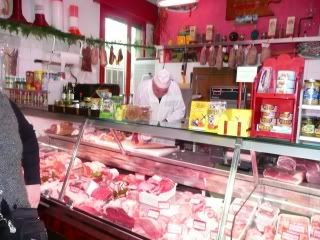
Unfortunately, in America the butcher is, for the most part, a thing of the past, gone the way of milkmen and the friendly neighborhood beat cop. While supermarket meat counters with their cellophane wrapped beef and pork delivered from a processing plant hundreds of miles away exist in Italy too, I was delighted to observe numerous traditional butchers in every town I visited on my most recent trip.
In Peschiera del Garda, our unofficial home base, our friend Mark prefers Macceleria da Piero, and so that is now my regular spot for buying meat. Piero and his wife run this establishment which is roughly the size of my kitchen at home. The meat is for the most part kept in it's primal cut form and then butchered to order. He grinds his own beef and pork for meatballs, sausage, etc. In addition to beef, lamb and pork, Piero stocks in chicken, rabbit, and guinea fowl, as well as a nice selection of salumi.
Pork Arista (bone in loin roasted with garlic and rosemary) is a traditional dish throughout Tuscany and the rest of northern Italy. According to legend, during a visit to Florence by Greek bishops in 1430, they were served pork loin roasted with garlic and rosemary, and it was so delicious that the Greeks proclaimed it "arista" (good in Greek). The name stuck. The traditional technique involves stabbing the roast all over with a long thin knife and filling the holes with garlic and herbs. I remember my grandmother making a dish like this for Sunday dinner when I was a kid.
In mid October, I visited Peschiera with my cousins, and our friend Mark invited us to his home to enjoy Piero's variation on traditional Arista. We joined Mark on his trip to Piero's shop and got to witness "il maestro" at work. We started by asking for a roast, and Piero asked how many people we had. He then went into his walk in and emerged with an entire pork loin primal (basically half a pig, minus the head and legs).
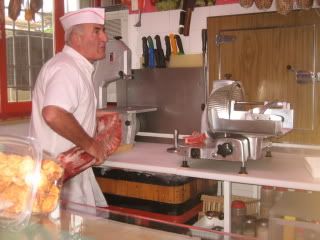
He chose a nice section of loin (about 9 ribs worth), and carved it out, cutting through the spine with a band saw. Piero began by "Frenching" the rib bones (scraping the meat down from the end of the ribs towards the body of the roast).
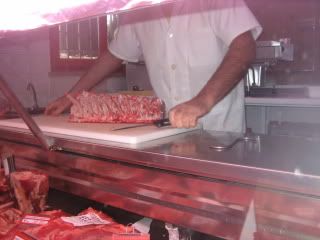
Instead of stabbing the roast and "studding" it with herbs and spices, he took his knife and ran it along the ribs down towards the chine bone as if he was going to make it into a boneless roast. Just before he separated the ribs from the loin, he turned his knife parallel to the board and began cutting into the loin meat while slowly rolling it away from the ribs.
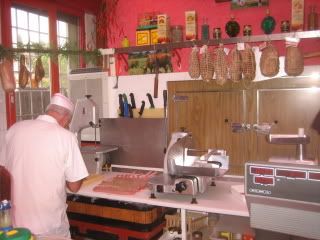
By doing this, he created a large rectangular piece of pork loin with the ribs still attached at one end.
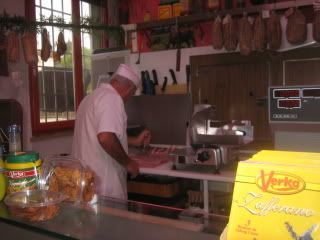
He pounded the meat with a mallet, then seasoned it with salt, pepper, garlic powder and fennel seeds.
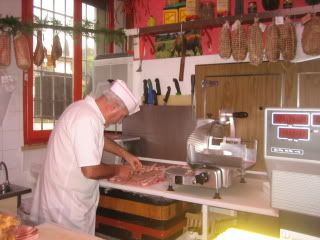
He then layered it with pancetta before rolling it back up like a jelly roll and tying it with string back to the ribs.
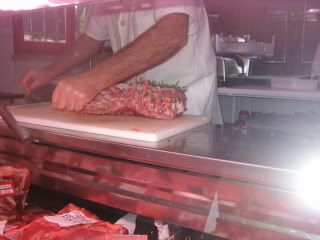
A few sprigs of fresh rosemary and some more pancetta on the outside, then thrown in the oven at 375 for about 2 and a half to 3 hours, and this is Piero's version of my grandma's Sunday roast pork. Mark and I are cut from the same piece of cloth (or is it pig?) and so he could not leave well enough alone and feels obligated to "guild the lilly".
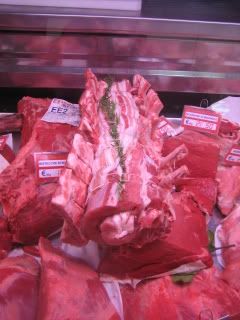
Because the ribs are the best part, he asked Piero to take a slab of pork ribs and tie it to the other side of the roast. We then took this back to Mark's house and cooked it on a charcoal rotisserie with some hardwood chunks thrown in for a little natural smoke flavor.
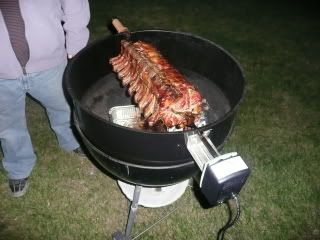
Three hours later, the meat was ready.
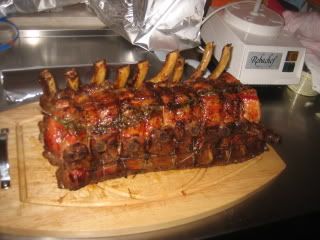
Often times, pork loin is so lean that it has a tendency to dry out, but with the pancetta rolled inside it stayed moist and tender, the herbs and spices perfuming it perfectly. I tried this dish at home last Sunday, with the only difference being that I roasted it in the oven instead of barbecuing it. It was very good, but I can definitely say that the wood smoke and the charcoal added significantly to the flavor and I would recommend doing it that way if at all possible.
One final observation on the experience of a visit to the butcher. This roast was prepared to order in a little mom and pop shop, Piero cutting the meat and his wife at the cash register. Occasionally she went behind the counter and handed him spices or cut the string for him as he tied up our roast. The process took about 20 minutes from start to finish and as he worked other customers came in and waited patiently till he completed our order. We chatted with the other customers about how we planned to cook the roast, and everyone was cordial and no one seemed to mind that they had to wait to be served. There is a large chain supermarket about 2oo yards up the road, and it would have been faster (and probably cheaper) for someone to go there and grab a plastic wrapped, pre-cut steak or pork chop from the unattended meat counter. And yet people came and waited, appreciating Piero's quality of product and skill with knife, saw and twine..... as it should be!
3 comments:
Mmmm that looks so good! I liked the idea of putting the extra ribs on the other side!
Hey Tom thanks for commenting. I appreciate feedback, so if anyone else is checking this blog out, please let me know.
I miss having a true butcher. My first job was in a grocery store and back then, they at least still worked on the primal cuts. Now VERY LITTLE cutting is done in the meat market of grocery stores. I was fortunate to have a great manager who taught me (even though I was not supposed to be doing anything but cleaning since I was under age) a lot about trimming cuts.
That roast looks phenomenal. I might go get me a pork loin and french cut it.
Post a Comment